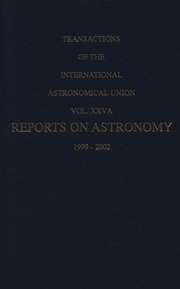No CrossRef data available.
Article contents
21. Light of the Night Sky (Lumiere Du Ciel Nocturne)
Published online by Cambridge University Press: 25 April 2016
Extract
The different components of the light of the night sky have their origin in different formations of matter in the universe - encompassing a huge scale of distances ranging from a few kilometers in the earth’s atmosphere to the most distant known galaxies and beyond. Correspondingly, the borderlines to other Commissions are not very well defined and thus material relevant to Commission 21 can also be found in the reports of other Commissions on the following topics: zodiacal light and zodiacal IR emission (Comm. 22, 44), integrated starlight (33, 25), diffuse galactic light (34), extragalactic background light (47), airglow and atmospheric scattered light (50), and space-borne observations of the LONS (44). From the Commission 21 point of view the connecting link between these various fields is the special techniques utilized in the surface photometric measurements and reductions of background radiations which extend over the entire sky. One crucial problem is the separation of the LONS into its several components. The approach for solving this task is to utilize the different spatial distributions and different broad and narrow band spectral properties of each of the LONS component. Thus the successful measurement and separation of one of the LONS components requires a knowledge of the properties of all the other components. This situation has become apparent in recent years as the infrared background radiation database, provided by the Infrared Astronomical Satellite (IRAS), has been analyzed: both the zodiacal and galactic dust emissions have to be analyzed hand in hand, and both these components must be very accurately mastered before any conclusions are possible on the extragalactic component. It is also obvious that very similar problems are encountered in the ultraviolet and infrared wavelength regions as in the more traditional optical domain. Thus the techniques developed in one of these wavelength domains are directly applicable in the others.
- Type
- Research Article
- Information
- Copyright
- Copyright © Kluwer 1988


